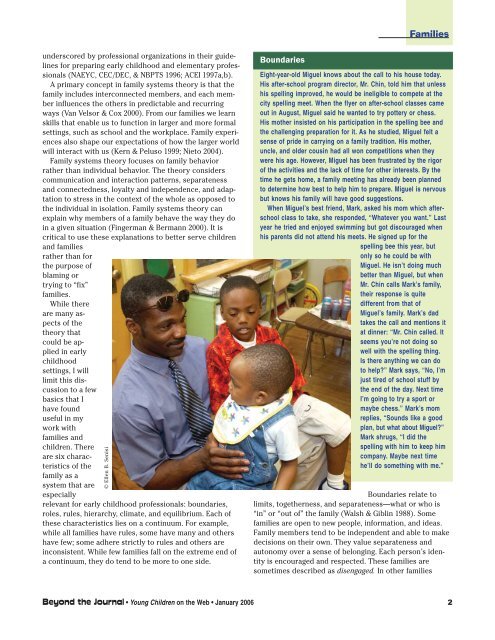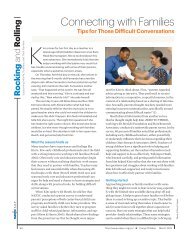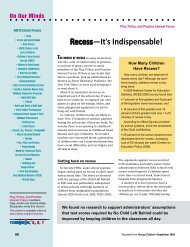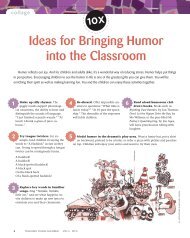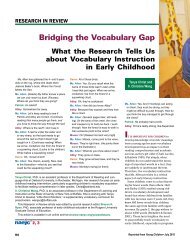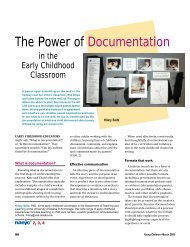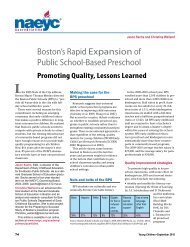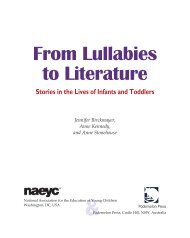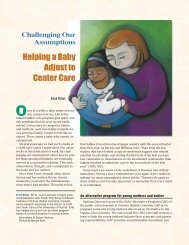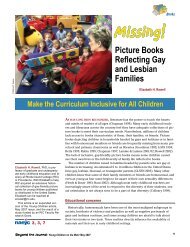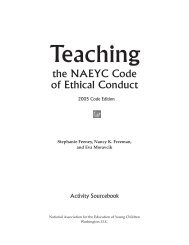Understanding Families - National Association for the Education of ...
Understanding Families - National Association for the Education of ...
Understanding Families - National Association for the Education of ...
Create successful ePaper yourself
Turn your PDF publications into a flip-book with our unique Google optimized e-Paper software.
underscored by pr<strong>of</strong>essional organizations in <strong>the</strong>ir guidelines<br />
<strong>for</strong> preparing early childhood and elementary pr<strong>of</strong>essionals<br />
(NAEYC, CEC/DEC, & NBPTS 1996; ACEI 1997a,b).<br />
A primary concept in family systems <strong>the</strong>ory is that <strong>the</strong><br />
family includes interconnected members, and each member<br />
influences <strong>the</strong> o<strong>the</strong>rs in predictable and recurring<br />
ways (Van Velsor & Cox 2000). From our families we learn<br />
skills that enable us to function in larger and more <strong>for</strong>mal<br />
settings, such as school and <strong>the</strong> workplace. Family experiences<br />
also shape our expectations <strong>of</strong> how <strong>the</strong> larger world<br />
will interact with us (Kern & Peluso 1999; Nieto 2004).<br />
Family systems <strong>the</strong>ory focuses on family behavior<br />
ra<strong>the</strong>r than individual behavior. The <strong>the</strong>ory considers<br />
communication and interaction patterns, separateness<br />
and connectedness, loyalty and independence, and adaptation<br />
to stress in <strong>the</strong> context <strong>of</strong> <strong>the</strong> whole as opposed to<br />
<strong>the</strong> individual in isolation. Family systems <strong>the</strong>ory can<br />
explain why members <strong>of</strong> a family behave <strong>the</strong> way <strong>the</strong>y do<br />
in a given situation (Fingerman & Bermann 2000). It is<br />
critical to use <strong>the</strong>se explanations to better serve children<br />
and families<br />
ra<strong>the</strong>r than <strong>for</strong><br />
<strong>the</strong> purpose <strong>of</strong><br />
blaming or<br />
trying to “fix”<br />
families.<br />
While <strong>the</strong>re<br />
are many aspects<br />
<strong>of</strong> <strong>the</strong><br />
<strong>the</strong>ory that<br />
could be applied<br />
in early<br />
childhood<br />
settings, I will<br />
limit this discussion<br />
to a few<br />
basics that I<br />
have found<br />
useful in my<br />
work with<br />
families and<br />
children. There<br />
are six characteristics<br />
<strong>of</strong> <strong>the</strong><br />
family as a<br />
system that are<br />
especially<br />
relevant <strong>for</strong> early childhood pr<strong>of</strong>essionals: boundaries,<br />
roles, rules, hierarchy, climate, and equilibrium. Each <strong>of</strong><br />
<strong>the</strong>se characteristics lies on a continuum. For example,<br />
while all families have rules, some have many and o<strong>the</strong>rs<br />
have few; some adhere strictly to rules and o<strong>the</strong>rs are<br />
inconsistent. While few families fall on <strong>the</strong> extreme end <strong>of</strong><br />
a continuum, <strong>the</strong>y do tend to be more to one side.<br />
© Ellen B. Senisi<br />
Boundaries<br />
<strong>Families</strong><br />
Eight-year-old Miguel knows about <strong>the</strong> call to his house today.<br />
His after-school program director, Mr. Chin, told him that unless<br />
his spelling improved, he would be ineligible to compete at <strong>the</strong><br />
city spelling meet. When <strong>the</strong> flyer on after-school classes came<br />
out in August, Miguel said he wanted to try pottery or chess.<br />
His mo<strong>the</strong>r insisted on his participation in <strong>the</strong> spelling bee and<br />
<strong>the</strong> challenging preparation <strong>for</strong> it. As he studied, Miguel felt a<br />
sense <strong>of</strong> pride in carrying on a family tradition. His mo<strong>the</strong>r,<br />
uncle, and older cousin had all won competitions when <strong>the</strong>y<br />
were his age. However, Miguel has been frustrated by <strong>the</strong> rigor<br />
<strong>of</strong> <strong>the</strong> activities and <strong>the</strong> lack <strong>of</strong> time <strong>for</strong> o<strong>the</strong>r interests. By <strong>the</strong><br />
time he gets home, a family meeting has already been planned<br />
to determine how best to help him to prepare. Miguel is nervous<br />
but knows his family will have good suggestions.<br />
When Miguel’s best friend, Mark, asked his mom which afterschool<br />
class to take, she responded, “Whatever you want.” Last<br />
year he tried and enjoyed swimming but got discouraged when<br />
his parents did not attend his meets. He signed up <strong>for</strong> <strong>the</strong><br />
spelling bee this year, but<br />
only so he could be with<br />
Miguel. He isn’t doing much<br />
better than Miguel, but when<br />
Mr. Chin calls Mark’s family,<br />
<strong>the</strong>ir response is quite<br />
different from that <strong>of</strong><br />
Miguel’s family. Mark’s dad<br />
takes <strong>the</strong> call and mentions it<br />
at dinner: “Mr. Chin called. It<br />
seems you’re not doing so<br />
well with <strong>the</strong> spelling thing.<br />
Is <strong>the</strong>re anything we can do<br />
to help?” Mark says, “No, I’m<br />
just tired <strong>of</strong> school stuff by<br />
<strong>the</strong> end <strong>of</strong> <strong>the</strong> day. Next time<br />
I’m going to try a sport or<br />
maybe chess.” Mark’s mom<br />
replies, “Sounds like a good<br />
plan, but what about Miguel?”<br />
Mark shrugs, “I did <strong>the</strong><br />
spelling with him to keep him<br />
company. Maybe next time<br />
he’ll do something with me.”<br />
Boundaries relate to<br />
limits, toge<strong>the</strong>rness, and separateness—what or who is<br />
“in” or “out <strong>of</strong>” <strong>the</strong> family (Walsh & Giblin 1988). Some<br />
families are open to new people, in<strong>for</strong>mation, and ideas.<br />
Family members tend to be independent and able to make<br />
decisions on <strong>the</strong>ir own. They value separateness and<br />
autonomy over a sense <strong>of</strong> belonging. Each person’s identity<br />
is encouraged and respected. These families are<br />
sometimes described as disengaged. In o<strong>the</strong>r families<br />
Beyond <strong>the</strong> Journal Young Children on <strong>the</strong> Web January 2006 2


